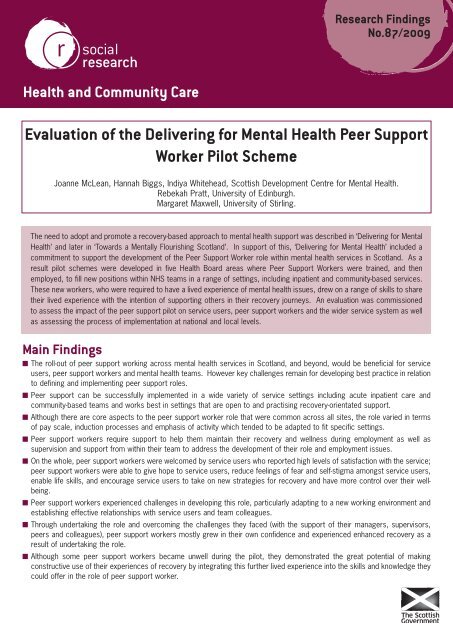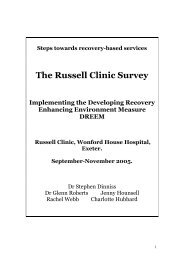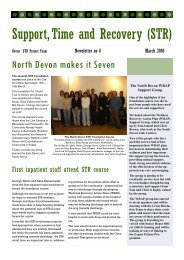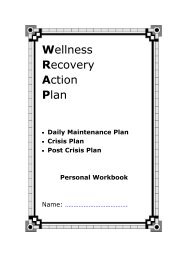Evaluation of the delivering for mental health peer support worker ...
Evaluation of the delivering for mental health peer support worker ...
Evaluation of the delivering for mental health peer support worker ...
You also want an ePaper? Increase the reach of your titles
YUMPU automatically turns print PDFs into web optimized ePapers that Google loves.
Research FindingsNo.87/2009Health and Community Care<strong>Evaluation</strong> <strong>of</strong> <strong>the</strong> Delivering <strong>for</strong> Mental Health Peer SupportWorker Pilot SchemeJoanne McLean, Hannah Biggs, Indiya Whitehead, Scottish Development Centre <strong>for</strong> Mental Health.Rebekah Pratt, University <strong>of</strong> Edinburgh.Margaret Maxwell, University <strong>of</strong> Stirling.The need to adopt and promote a recovery-based approach to <strong>mental</strong> <strong>health</strong> <strong>support</strong> was described in ‘Delivering <strong>for</strong> MentalHealth’ and later in ‘Towards a Mentally Flourishing Scotland’. In <strong>support</strong> <strong>of</strong> this, ‘Delivering <strong>for</strong> Mental Health’ included acommitment to <strong>support</strong> <strong>the</strong> development <strong>of</strong> <strong>the</strong> Peer Support Worker role within <strong>mental</strong> <strong>health</strong> services in Scotland. As aresult pilot schemes were developed in five Health Board areas where Peer Support Workers were trained, and <strong>the</strong>nemployed, to fill new positions within NHS teams in a range <strong>of</strong> settings, including inpatient and community-based services.These new <strong>worker</strong>s, who were required to have a lived experience <strong>of</strong> <strong>mental</strong> <strong>health</strong> issues, drew on a range <strong>of</strong> skills to share<strong>the</strong>ir lived experience with <strong>the</strong> intention <strong>of</strong> <strong>support</strong>ing o<strong>the</strong>rs in <strong>the</strong>ir recovery journeys. An evaluation was commissionedto assess <strong>the</strong> impact <strong>of</strong> <strong>the</strong> <strong>peer</strong> <strong>support</strong> pilot on service users, <strong>peer</strong> <strong>support</strong> <strong>worker</strong>s and <strong>the</strong> wider service system as wellas assessing <strong>the</strong> process <strong>of</strong> implementation at national and local levels.Main Findings■ The roll-out <strong>of</strong> <strong>peer</strong> <strong>support</strong> working across <strong>mental</strong> <strong>health</strong> services in Scotland, and beyond, would be beneficial <strong>for</strong> serviceusers, <strong>peer</strong> <strong>support</strong> <strong>worker</strong>s and <strong>mental</strong> <strong>health</strong> teams. However key challenges remain <strong>for</strong> developing best practice in relationto defining and implementing <strong>peer</strong> <strong>support</strong> roles.■ Peer <strong>support</strong> can be successfully implemented in a wide variety <strong>of</strong> service settings including acute inpatient care andcommunity-based teams and works best in settings that are open to and practising recovery-orientated <strong>support</strong>.■ Although <strong>the</strong>re are core aspects to <strong>the</strong> <strong>peer</strong> <strong>support</strong> <strong>worker</strong> role that were common across all sites, <strong>the</strong> role varied in terms<strong>of</strong> pay scale, induction processes and emphasis <strong>of</strong> activity which tended to be adapted to fit specific settings.■ Peer <strong>support</strong> <strong>worker</strong>s require <strong>support</strong> to help <strong>the</strong>m maintain <strong>the</strong>ir recovery and wellness during employment as well assupervision and <strong>support</strong> from within <strong>the</strong>ir team to address <strong>the</strong> development <strong>of</strong> <strong>the</strong>ir role and employment issues.■ On <strong>the</strong> whole, <strong>peer</strong> <strong>support</strong> <strong>worker</strong>s were welcomed by service users who reported high levels <strong>of</strong> satisfaction with <strong>the</strong> service;<strong>peer</strong> <strong>support</strong> <strong>worker</strong>s were able to give hope to service users, reduce feelings <strong>of</strong> fear and self-stigma amongst service users,enable life skills, and encourage service users to take on new strategies <strong>for</strong> recovery and have more control over <strong>the</strong>ir wellbeing.■ Peer <strong>support</strong> <strong>worker</strong>s experienced challenges in developing this role, particularly adapting to a new working environment andestablishing effective relationships with service users and team colleagues.■ Through undertaking <strong>the</strong> role and overcoming <strong>the</strong> challenges <strong>the</strong>y faced (with <strong>the</strong> <strong>support</strong> <strong>of</strong> <strong>the</strong>ir managers, supervisors,<strong>peer</strong>s and colleagues), <strong>peer</strong> <strong>support</strong> <strong>worker</strong>s mostly grew in <strong>the</strong>ir own confidence and experienced enhanced recovery as aresult <strong>of</strong> undertaking <strong>the</strong> role.■ Although some <strong>peer</strong> <strong>support</strong> <strong>worker</strong>s became unwell during <strong>the</strong> pilot, <strong>the</strong>y demonstrated <strong>the</strong> great potential <strong>of</strong> makingconstructive use <strong>of</strong> <strong>the</strong>ir experiences <strong>of</strong> recovery by integrating this fur<strong>the</strong>r lived experience into <strong>the</strong> skills and knowledge <strong>the</strong>ycould <strong>of</strong>fer in <strong>the</strong> role <strong>of</strong> <strong>peer</strong> <strong>support</strong> <strong>worker</strong>.
■ Peer <strong>support</strong> <strong>worker</strong>s were able to bridge <strong>the</strong> ‘<strong>the</strong>m and us’ gap that <strong>of</strong>ten exists between service users and pr<strong>of</strong>essionalteams by <strong>of</strong>fering pr<strong>of</strong>essionals fur<strong>the</strong>r insights into <strong>the</strong> service user’s own personal work in <strong>the</strong>ir recovery journey, remindingpr<strong>of</strong>essionals <strong>of</strong> <strong>the</strong> courage and ef<strong>for</strong>ts required <strong>for</strong> individuals to make progress and helping service users to be open totrying new approaches to <strong>the</strong>ir care.■ Despite initial difficulties, particularly around confidentiality and in<strong>for</strong>mation sharing and <strong>the</strong> impact <strong>of</strong> this on <strong>the</strong> <strong>peer</strong>relationship, <strong>peer</strong> <strong>support</strong> <strong>worker</strong>s were able to integrate well with <strong>the</strong>ir multidisciplinary teams, gaining respect andcooperation from most <strong>of</strong> <strong>the</strong>ir colleagues.■ Peer <strong>support</strong> <strong>of</strong>fers a unique and complementary role to <strong>mental</strong> <strong>health</strong> teams, streng<strong>the</strong>ning a team-based approach torecovery, which <strong>for</strong>mally values <strong>the</strong> contribution <strong>of</strong> sharing lived experiences, although some staff remained resistant to <strong>peer</strong><strong>support</strong>.<strong>Evaluation</strong> aimsThe aims <strong>of</strong> <strong>the</strong> evaluation were to assess <strong>the</strong> impact <strong>of</strong> <strong>the</strong><strong>peer</strong> <strong>support</strong> pilot on service users, <strong>peer</strong> <strong>support</strong> <strong>worker</strong>sand <strong>the</strong> wider service system as well as assessing <strong>the</strong>process <strong>of</strong> implementation at national and local levels.In-depth interviews, a satisfaction survey and a significantevents analysis were used to track <strong>the</strong> process <strong>of</strong>implementation and <strong>the</strong> impact <strong>of</strong> <strong>the</strong> new <strong>peer</strong> <strong>support</strong><strong>worker</strong>s on <strong>the</strong> service teams and systems within which <strong>the</strong>yworked. Qualitative data was analysed using a <strong>the</strong>maticanalysis approach.Impact on service usersThe impact <strong>of</strong> <strong>peer</strong> <strong>support</strong> <strong>worker</strong>s on service users hasbeen on <strong>the</strong> whole positive, with <strong>peer</strong> <strong>support</strong> <strong>worker</strong>s ableto:■ Provide service users with hope <strong>of</strong> recovery andaspirations <strong>for</strong> <strong>the</strong> future at all stages <strong>of</strong> <strong>mental</strong> ill <strong>health</strong>and recovery.■ Act as a conduit between service users and clinical staff,providing both groups with fur<strong>the</strong>r insight into each o<strong>the</strong>r’sperspectives and enabling <strong>the</strong>m to approach recoveryusing new strategies which are helpful to service users.■ Encourage service users to take more control <strong>of</strong> <strong>the</strong>ir ownrecovery through enabling activities and using WellnessRecovery Action Planning (WRAP).Service users, on <strong>the</strong> whole, welcomed <strong>the</strong> option <strong>of</strong> workingwith a <strong>peer</strong> <strong>support</strong> <strong>worker</strong> at any stage <strong>of</strong> <strong>mental</strong> ill <strong>health</strong>and / or recovery. In a few cases, service users rejected <strong>the</strong><strong>peer</strong> <strong>support</strong> <strong>worker</strong>’s help.Impact on <strong>peer</strong> <strong>support</strong> <strong>worker</strong>sThe impact on <strong>peer</strong> <strong>support</strong> <strong>worker</strong>s <strong>of</strong> taking on <strong>the</strong> roleand <strong>the</strong> extent to which <strong>the</strong>y are able to promote andmaintain <strong>the</strong>ir own recovery was explored in detail. Peer<strong>support</strong> <strong>worker</strong>s were faced with a number <strong>of</strong> challenges,such as:■ Adjusting to employment after many years <strong>of</strong> not working.■ Developing <strong>the</strong>ir role from scratch.■ Learning about <strong>the</strong>ir new working environment.■ Integrating with teams whilst challenging non-recoveryfocussed practice within those teams.■ Being confronted with service-user problems thatreminded <strong>the</strong>m <strong>of</strong> <strong>the</strong>ir own most difficult times.Dealing with <strong>the</strong>se challenges (with <strong>the</strong> <strong>support</strong> <strong>of</strong>supervisors) helped <strong>peer</strong> <strong>support</strong> <strong>worker</strong>s to gain confidenceand self esteem regarding <strong>the</strong>ir contribution towards helpingo<strong>the</strong>rs and influencing NHS culture. For many <strong>peer</strong> <strong>support</strong><strong>worker</strong>s this contributed to <strong>the</strong>ir going fur<strong>the</strong>r in <strong>the</strong>ir ownrecovery journeys. Although some <strong>peer</strong> <strong>support</strong> <strong>worker</strong>sbecame unwell during <strong>the</strong>ir period <strong>of</strong> employment, this wasapproached by <strong>the</strong>m and <strong>the</strong>ir employers in a positive light,and <strong>peer</strong> <strong>support</strong> <strong>worker</strong>s tended to make constructive use<strong>of</strong> <strong>the</strong>ir experiences <strong>of</strong> recovery, refreshing <strong>the</strong>ir knowledge.Impact on <strong>the</strong> service systemA positive and considerable impact was made upon <strong>the</strong>service system and <strong>the</strong> service culture, values and practicein a short space <strong>of</strong> time.Some difficulties were experienced, but overcome, in pilotsites regarding meeting Agenda <strong>for</strong> Change andOccupational Health requirements.Although most <strong>peer</strong> <strong>support</strong> <strong>worker</strong>s felt well prepared totake on <strong>the</strong> role <strong>of</strong> <strong>peer</strong> <strong>support</strong> <strong>worker</strong>, <strong>the</strong>y felt that futuretraining and induction processes should involve morepreparation <strong>for</strong> working in settings such as <strong>the</strong> NHS, impacton benefits, management <strong>of</strong> aggression, risk assessmentand influencing change.Peer <strong>support</strong> <strong>worker</strong>s have learned about <strong>the</strong> art <strong>of</strong>influencing change by trial and error and raised this as animportant learning curve. Peer <strong>support</strong> <strong>worker</strong>s seem tohave been effective in breaking down barriers around <strong>the</strong>‘<strong>the</strong>m and us’ culture that still exists within many NHSservices. Even those teams which are quite progressive interms <strong>of</strong> <strong>the</strong>ir recovery approach have found that <strong>the</strong> <strong>peer</strong><strong>support</strong> <strong>worker</strong> has helped <strong>the</strong>m to be mindful <strong>of</strong> <strong>the</strong>principles <strong>of</strong> recovery and develop more effective strategies<strong>for</strong> applying this to <strong>the</strong>ir practice.A conclusive finding was that <strong>peer</strong> <strong>support</strong> <strong>worker</strong>s thrivedand had positive impacts on service users and culture in arange <strong>of</strong> settings. However, it was essential that <strong>the</strong> serviceor team in which <strong>peer</strong> <strong>support</strong> <strong>worker</strong>s are based must beopen to and starting to implement a recovery-focussedapproach to <strong>the</strong>ir practice.2
Uniqueness <strong>of</strong> <strong>peer</strong> <strong>support</strong>Many factors make <strong>the</strong> <strong>peer</strong> <strong>support</strong> <strong>worker</strong> approachdistinctive and positive, <strong>the</strong> main one being <strong>the</strong> sharing <strong>of</strong>lived experience as a strength. Ano<strong>the</strong>r key feature was <strong>peer</strong><strong>support</strong> <strong>worker</strong>s’ ability to use <strong>the</strong>ir insight, empathy, andcommitment to mutuality in <strong>the</strong>ir relationship with serviceusers which has helped teams to overcome <strong>the</strong> ‘<strong>the</strong>m and us’relationship. This has <strong>the</strong> potential to <strong>support</strong> <strong>mental</strong> <strong>health</strong>services to be more effective in <strong>the</strong> service <strong>the</strong>y <strong>of</strong>fer. Peer<strong>support</strong> <strong>worker</strong>s were viewed by many <strong>of</strong> <strong>the</strong>ir staffcolleagues as a unique and essential part <strong>of</strong> <strong>the</strong> multidisciplinaryteam.RecommendationsThe findings from <strong>the</strong> pilot indicate that <strong>the</strong> roll-out <strong>of</strong> <strong>peer</strong><strong>support</strong> working across <strong>mental</strong> <strong>health</strong> services in Scotland,and beyond, would have a positive impact <strong>for</strong> service usersand <strong>mental</strong> <strong>health</strong> teams. It will be important to develop aclear set <strong>of</strong> national guidelines <strong>for</strong> <strong>the</strong> effectiveimplementation <strong>of</strong> <strong>peer</strong> <strong>support</strong> working within both statutoryand voluntary services. The following factors shouldcontribute to <strong>the</strong> effective implementation <strong>of</strong> <strong>peer</strong> <strong>support</strong>working leading to improvement in services.Recruitment, preparation and set up■ Peer <strong>support</strong> can be based in any setting that is recoveryfocussedin ethos, although more challenging settingssuch as acute inpatient wards might suit <strong>peer</strong> <strong>support</strong><strong>worker</strong>s with more experience and confidence.■ Partnerships between voluntary sector service providersand <strong>the</strong> NHS can work well in developing and providing a<strong>peer</strong> <strong>support</strong> service.■ To ensure continuity and maximum benefit <strong>for</strong> serviceusers, <strong>peer</strong> <strong>support</strong> should be available in acute andrehabilitation inpatient and community-based teams.■ Opportunities to affect a more lasting impact on <strong>the</strong>service users are maximised when <strong>the</strong>re is time <strong>for</strong> <strong>peer</strong><strong>support</strong> <strong>worker</strong>s to build good relationships with serviceusers.■ Peer <strong>support</strong> <strong>worker</strong>s should be treated <strong>the</strong> same as anyo<strong>the</strong>r employee in relation to <strong>the</strong>ir employment terms andconditions.■ Standardisation <strong>of</strong> a core <strong>peer</strong> <strong>support</strong> <strong>worker</strong> jobdescription that fits with ‘Agenda <strong>for</strong> Change’requirements would assist efficient recruitment and fairergrading <strong>of</strong> jobs.■ The criteria required <strong>for</strong> <strong>peer</strong> <strong>support</strong> working, alongsidea lived experience, should include good communicationskills, positive attitude to recovery, and knowledge <strong>of</strong> arange <strong>of</strong> self-management strategies. Employers shouldbe open about <strong>the</strong> potentially stressful nature <strong>of</strong> <strong>the</strong> <strong>peer</strong><strong>support</strong> <strong>worker</strong> role and emphasise <strong>the</strong> importance <strong>of</strong><strong>peer</strong> <strong>support</strong> <strong>worker</strong> applicants being at an appropriatestage in <strong>the</strong>ir recovery to handle <strong>the</strong> pressures involved.■ Guidance <strong>for</strong> Occupational Health pr<strong>of</strong>essionals regardingraising awareness about <strong>the</strong> <strong>peer</strong> <strong>support</strong> <strong>worker</strong> roleshould be provided.■ Peer <strong>support</strong> <strong>worker</strong>s should be <strong>for</strong>mally trained on acourse which covers preparation <strong>for</strong> return toemployment, working in <strong>the</strong> NHS and influencing change.■ Staff on teams that will be introducing <strong>peer</strong> <strong>support</strong>should be given training on <strong>the</strong> <strong>peer</strong> <strong>support</strong> <strong>worker</strong> roleand how it will fit in with <strong>the</strong>ir role as well as generalawareness raising about <strong>the</strong> advantages and challengesassociated with <strong>peer</strong> <strong>support</strong>.■ Clear guidance on patient confidentiality issues should beagreed within services and teams employing <strong>peer</strong> <strong>support</strong><strong>worker</strong>s and provided <strong>for</strong> all Peer Support Workers.■ A full and thorough induction should be <strong>of</strong>fered to all new<strong>peer</strong> <strong>support</strong> <strong>worker</strong>s and in-house training should beconsidered e.g. suicide prevention training, values andrecovery-based training and management <strong>of</strong> aggression.Integration to <strong>the</strong> team and organisation■ Strong <strong>support</strong> from senior service management andpsychiatry should create <strong>the</strong> conditions necessary <strong>for</strong> a<strong>support</strong>ive and progressive working environment <strong>for</strong> <strong>peer</strong><strong>support</strong> <strong>worker</strong>s.■ Peer <strong>support</strong> <strong>worker</strong>s should only be placed in <strong>support</strong>iveenvironments as a way to enhance, but not introduce,recovery.■ Teams should be clear about how <strong>the</strong> <strong>peer</strong> <strong>support</strong> <strong>worker</strong>role will fit in with <strong>the</strong>ir current practice and team workingsystems including in<strong>for</strong>mation sharing, and wherepossible, operational policies should be reviewed toaccommodate <strong>the</strong> <strong>peer</strong> <strong>support</strong> <strong>worker</strong> role.■ Documentation should be produced <strong>for</strong> referralprocesses, note keeping or writing inpatient user notes, topromote <strong>the</strong> service.■ Systems to manage in<strong>for</strong>mation about <strong>peer</strong> <strong>support</strong><strong>worker</strong> activity should be developed.■ Room should be left <strong>for</strong> <strong>the</strong> <strong>peer</strong> <strong>support</strong> <strong>worker</strong> and <strong>the</strong>irteam colleagues to develop <strong>the</strong> <strong>peer</strong> <strong>support</strong> <strong>worker</strong> rolegradually but systematically.■ Opportunities should be provided <strong>for</strong> teams to discussand review <strong>the</strong> potential and actual impact <strong>of</strong> <strong>peer</strong> <strong>support</strong>on team and individual working and practice prior to andfollowing <strong>the</strong> introduction <strong>of</strong> <strong>peer</strong> <strong>support</strong> <strong>worker</strong>s.■ Peer <strong>support</strong> <strong>worker</strong>s must be fully involved in any teamreviews following significant events e.g. suicide.■ In<strong>for</strong>mation materials (such as leaflets) about <strong>the</strong> nature <strong>of</strong><strong>peer</strong> <strong>support</strong>, how it can be <strong>of</strong> help and how to access <strong>the</strong>service should be made available to service users withcontact details <strong>of</strong> an individual(s) who can provide fur<strong>the</strong>rin<strong>for</strong>mation.■ Peer <strong>support</strong> <strong>worker</strong>s require supervision and <strong>support</strong> intwo main areas. They need <strong>support</strong> to help <strong>the</strong>m maintain<strong>the</strong>ir recovery and wellness during employment as well as<strong>support</strong> from within <strong>the</strong>ir team to address <strong>the</strong>development <strong>of</strong> <strong>the</strong>ir role and any operational andemployment issues.3
Building in sustainability■ Sustainable and available training <strong>for</strong> <strong>peer</strong> <strong>support</strong><strong>worker</strong>s is required to ensure that new <strong>peer</strong> <strong>support</strong><strong>worker</strong>s can be employed. Until <strong>the</strong>n, it is not expectedthat a rollout will be possible.■ Peer <strong>support</strong> <strong>worker</strong>s absences from work could beviewed constructively by <strong>the</strong>m, <strong>the</strong>ir employers andcolleagues in that when an absence is due to <strong>mental</strong><strong>health</strong> problems, <strong>the</strong> process <strong>of</strong> <strong>the</strong> <strong>peer</strong> <strong>support</strong> <strong>worker</strong>regaining <strong>the</strong>ir recovery can enhance <strong>the</strong> approach <strong>the</strong>ytake to drawing on <strong>the</strong>ir lived experience to <strong>support</strong>o<strong>the</strong>rs.■ Employers will also need to build in strategies to providecover <strong>for</strong> long term absences.National <strong>support</strong>The pilot helped to identify a number <strong>of</strong> ways in whichnational <strong>support</strong> <strong>for</strong> <strong>the</strong> roll-out <strong>of</strong> <strong>peer</strong> <strong>support</strong> workingcould be delivered including:■ A clearly identified national champion <strong>for</strong> <strong>peer</strong> <strong>support</strong> (<strong>the</strong>Scottish Recovery Network currently provides a nationallead <strong>for</strong> <strong>peer</strong> <strong>support</strong> developments within Scotland andthis role should be rein<strong>for</strong>ced).■ National facilitation <strong>of</strong> networks / learning sets.■ Providing guidance that can be used by local employers toraise awareness <strong>of</strong> <strong>the</strong> <strong>peer</strong> <strong>support</strong> role within peripheryservices such as Occupational Health who will be lessdirectly involved in <strong>the</strong> recruitment and employment <strong>of</strong><strong>peer</strong> <strong>support</strong> <strong>worker</strong>s but still play a crucial role.Issues <strong>for</strong> fur<strong>the</strong>r considerationA number <strong>of</strong> issues remain unresolved includingstandardisation <strong>of</strong> job descriptions, pay scales, sharingin<strong>for</strong>mation within multi-disciplinary teams, levels <strong>of</strong>responsibility and career development. The long-termobjective <strong>of</strong> how <strong>peer</strong> <strong>support</strong> should feature within <strong>mental</strong><strong>health</strong> service delivery in <strong>the</strong> future is also not clearlydefined. Continuing <strong>the</strong> debates required to resolve <strong>the</strong>seissues is important <strong>for</strong> ensuring <strong>the</strong> ongoing development <strong>of</strong>this innovative and important role <strong>for</strong> <strong>mental</strong> <strong>health</strong> servicesin Scotland.This document, along with full research report <strong>of</strong> <strong>the</strong> project, and fur<strong>the</strong>r in<strong>for</strong>mation about social and policyresearch commissioned and published on behalf <strong>of</strong> <strong>the</strong> Scottish Government, can be viewed on <strong>the</strong> Internet at:http://www.scotland.gov.uk/socialresearch.If you have any fur<strong>the</strong>r queries about social research, or would like fur<strong>the</strong>r copies <strong>of</strong> this research findings summarydocument, please contact us at socialresearch@scotland.gsi.gov.uk or on 0131-244 7560.RR Donnelley B62689 11-094










